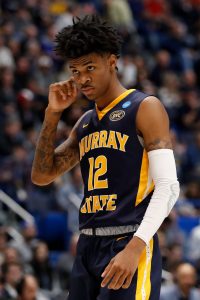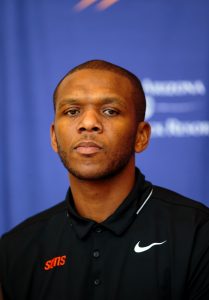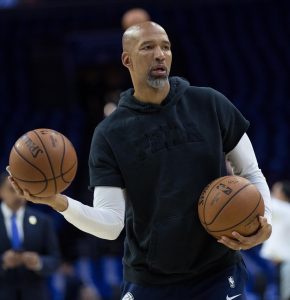It looked like the Suns might be on the upswing after they lucked into the No. 1 pick in the 2018 draft, then lured a coveted two-way forward (Trevor Ariza) away from the 65-win Rockets during free agency. However, things took an abrupt downward turn from there.
Team owner Robert Sarver‘s patience with GM Ryan McDonough ran out when Phoenix was unable to land a starting-caliber point guard in the offseason, prompting the club to fire McDonough right before the regular season began. Despite aspirations of postseason contention, the Suns spent virtually season in the basement of the Western Conference, selling off veterans like Ariza when it became clear that the playoffs were a pipe dream. To top it all off, first-year head coach Igor Kokoskov got his walking papers at season’s end.
With a new permanent GM (James Jones) and head coach (Monty Williams) now in place, there’s some optimism that this duo can finally be the winning combination for the Suns. But after losing at least 58 games for four straight seasons and not appearing in the playoffs since 2010, the team remains in prove-it mode.
Here are five key questions facing the franchise this summer:
 1. Will they acquire a starting point guard this year?
1. Will they acquire a starting point guard this year?
The days of Goran Dragic, Eric Bledsoe, and Isaiah Thomas vying for minutes in Phoenix are long gone. The team’s current point guard depth chart, which features 2018 draftees De’Anthony Melton and Elie Okobo and combo guard Tyler Johnson, is… well, a little thinner.
Unlike last year, the Suns are unlikely to have any cap room at their disposal during the 2019 offseason, which will limit their ability to add an impact player at the position. Barring major cost-cutting moves, it’s hard to imagine the team being able to make a play for a young point guard like D’Angelo Russell or Terry Rozier, both of whom will be restricted free agents.
Second-tier RFAs like Delon Wright or Tyus Jones could be in Phoenix’s price range, but those players have yet to show they can be reliable starters. On the unrestricted market, veterans like Patrick Beverley, Darren Collison, Cory Joseph, Rajon Rondo, and Ricky Rubio may be realistic targets for the Suns if they don’t receive other offers that exceed the mid-level.
Of course, the draft would provide the simplest path to securing a long-term answer at point guard, but the Suns will need some lottery luck to be in a position to snag Murray State’s Ja Morant, who looks like the consensus No. 2 pick in this year’s class. Although they finished in a tie for the league’s second-worst record, the Suns only have a 27.4% chance to land a top-two pick, thanks to the NBA’s new lottery format.
If the Suns can’t get Morant, Vanderbilt’s Darius Garland could be a viable fallback option — he’s ranked fourth among this year’s prospects on ESPN’s big board, and other teams near the top of the lottery, like the Cavaliers and Hawks, have already used lottery picks on point guards in recent years, making them less-likely suitors for someone like Garland.
Read more
2. Where will the Suns’ lottery pick land?
Due to those aforementioned changes to the lottery, the Suns’ odds next Tuesday won’t be as strong as they would have been in past years. Their most likely landing spot (26.0%) is No. 6. Under the old format, falling further than No. 5 would’ve been an extreme long shot.
Conversely though, no team has a better chance at landing the No. 1 pick (14.0%) – or a top-four pick (52.1%) – than the Suns, who have the same odds as their fellow bottom-three teams.
In an extremely top-heavy draft, the difference between ending up at No. 2 or No. 6 would be absolutely massive for the Suns. Of course, for a franchise that has used so many top-10 picks in recent years with so little to show for those picks, perhaps Phoenix doesn’t deserve any more lottery luck.
Still, being in a position to draft Morant would single-handedly make the Suns’ offseason a win. On the other hand, if they end up at No. 6 and have to choose from the likes of wings such as Cam Reddish and Jarrett Culver, it would really start the summer off on the wrong foot.
3. Which of the Suns’ forwards are keepers?
Ending up with a player like Reddish or Culver isn’t a bad thing, generally speaking, but if those are the best players available when the Suns are up, it would present some problems for the team. That’s because Phoenix already has a logjam at its forward and wing spots, with T.J. Warren, Mikal Bridges, and Josh Jackson under contract and Kelly Oubre facing restricted free agency.
The jury is still out on what sort of role Jackson can play on a postseason contender, but Warren has proven himself as a scorer and play-maker, and Bridges flashed promising potential in his rookie season. As for Oubre, he and the Suns appear to have mutual interest in continuing their relationship. Can the club find enough minutes for all four players going forward?
I’m betting the answer to that question is no, which means the Suns figure to explore trades this offseason to help clear the logjam. I doubt Bridges will go anywhere, and I think Oubre is a good bet to stick around too, despite his free agent status. That leaves Warren and Jackson as potential trade chips.
Jackson has the more team-friendly contract of the two, which boosts his trade value, but he also doesn’t have the professional résumé that Warren does, having turned in two up-and-down seasons in the NBA since being drafted fourth overall in 2017. If the Suns can find a team willing to bet on Jackson’s upside (he’s still just 22) and pay a fair price for him, he’s my pick for the team’s most likely trade candidate.
 4. How will James Jones’ philosophy affect the team’s direction?
4. How will James Jones’ philosophy affect the team’s direction?
As a former player who only retired from the game in 2017, Jones – who was named Phoenix’s permanent GM in April – seems like a candidate to value the influence on veteran contributors on a young roster. Yet his roster moves throughout the 2018/19 season suggested an entirely different philosophy.
With the exception of Jamal Crawford, who stuck around all year long, the Suns jettisoned most of their veterans over the course of the season. Tyson Chandler was bought out early, much to the surprise of league observers. Ariza was traded well before the deadline. And useful veterans acquired in trades – such as Austin Rivers and Wayne Ellington – were quickly waived as well, allowing them to become rotation pieces on playoff teams.
As someone who played on the Heat and Cavaliers with LeBron James throughout the second half of his career, perhaps Jones simply believes in doing right by veterans and allowing them to join contenders. Still, with the Suns’ direction unclear, it will be interesting to see how his attitude applies to the 2019 offseason.
Will Jones pursue veterans in free agency in the hopes of once again pushing for a playoff spot? Will he try to bring in one or two like Crawford who can help stabilize the locker room? Will he ignore vets altogether, fully embracing the rebuild and allowing his young players to get thrown in the deep end by playing big minutes? This offseason will represent Jones’ first major opportunity to put his stamp on the franchise, so it’s worth watching closely to see what that looks like.
5. Will the Suns have patience with Monty Williams?
It’s possible that 2016 Suns lottery picks Dragan Bender and Marquese Chriss wouldn’t have had great success in their first three NBA seasons under any circumstances, but the franchise didn’t exactly put them in a position to develop — Chriss played for two different head coaches in his two years in Phoenix, and Bender played for three in his three seasons.
For a team looking to nurture and develop its young players, stability is important. Just ask the Nets, who broke through this season after years of gradual improvement under Kenny Atkinson.
In Phoenix, Sarver has historically been impatient with his coaches, to the detriment of the Suns’ culture. Williams will be the Suns’ seventh head coach since the start of the 2012/13 season, and the team needs to make sure its coaching turnover doesn’t continue at that rate.
Signing Williams to a five-year contract is a good first step. Now, Sarver has to be patient with his new head coach, recognizing that things might not change overnight. Kokoskov, who was let go a year after he was hired, didn’t get a chance to prove that he could be a long-term fixture in Phoenix. The team needs to give Williams that opportunity.
Check out the Phoenix Suns’ offseason salary cap outlook right here.
Salary information from Basketball Insiders was used in the creation of this post. Photos courtesy of USA Today Sports Images.
 1. Will they acquire a starting point guard this year?
1. Will they acquire a starting point guard this year? 4. How will James Jones’ philosophy affect the team’s direction?
4. How will James Jones’ philosophy affect the team’s direction?